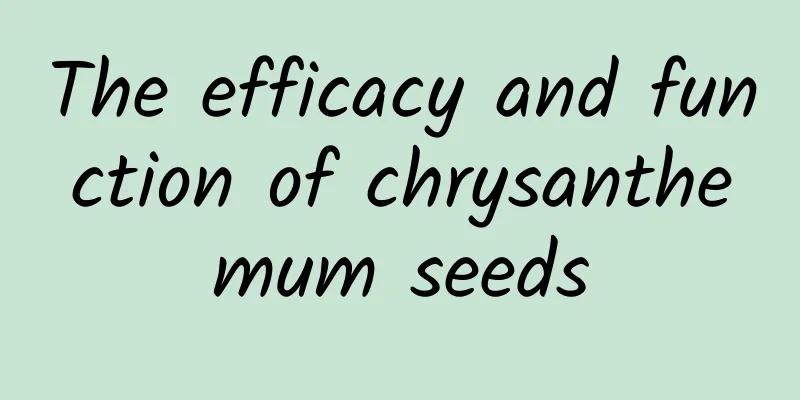The efficacy and function of chrysanthemum seeds

|
Chrysanthemum seeds are a common herb and can be found in many ranges in terms of properties. In life, many people use chrysanthemum seeds to treat or solve some medical problems. The application of chrysanthemum seeds in life is quite extensive. The application methods of chrysanthemum seeds are different for different disease symptoms, and you should also pay attention to the dosage when using it. 1. Traits Chrysanthemum chinense is an annual herb, 0.3~2m tall, with densely covered velvety stellate hairs throughout the plant. The leaves are alternate, heart-shaped, 7-18 cm in diameter, with long pointed tips, coarsely serrated edges, palmate veins, and long petioles. The flowers are solitary in the leaf axils, with 5-lobed calyx, green in color; there are 5 petals, which are yellow, inverted, with flat and concave apex and fused to the stamen tube at the base; there are many stamens, with the base of the filaments fused into a tube; there are 15 to 20 carpels, arranged in a flat spherical shape, with the tip protruding like an awn. The fruit is hemispherical and shaped like a millstone, densely covered with star-shaped hairs, and forms separate fruits when ripe. Seeds black. The flowering period is from July to October, and the fruiting period is from October to November. 2. Treat eye diseases Add 1 liter of chrysanthemum seeds, grind into powder, put into slices of pork liver, moxibustion until cooked, and cut into fine powder. Take a small amount each time, with rice soup. Take 3 times a day. 3. Unfamiliar cataract Use white sesame seeds, remove the shells, put them into thin slices of pork liver, slowly roast them until cooked, grind them into powder, add vinegar and make them into pills as big as walnuts. Take 310 pills each time with warm water. Another recipe: Put ramie seeds in a bag, steam them, dry them in the sun, grind them into powder, add honey to make them into balls, and take them with warm water. 4. Others Used to treat gonorrhea, edema and other diseases. The former is often used in combination with Plantago seed, Lygodium japonicum, etc., and the latter can be used in combination with Poria cocos. It is used for constipation and can be used in combination with peach kernel, Prunus mume kernel, etc. It has the effects of relieving dryness, lubricating the intestines and softening hard masses. It is used for symptoms such as milk obstruction and breast pain. It is often used in combination with pangolin, fenugreek, astragalus, pig's trotter, etc. It has the effect of promoting blood circulation and promoting lactation. |
<<: Effects and side effects of Shenshao tablets
>>: The best Chinese herbal medicine for lowering blood sugar
Recommend
The effects and functions of Liriodendron chinense root
There are so many medicinal herbs in the world, a...
The efficacy and function of stonehead fish
Chinese medicinal materials are very common, and ...
Which additive in soy sauce is more terrible? How to choose soy sauce
During the holidays, several acquaintances and fr...
Welcome home! What innovative technologies will help Shenzhou 15 return home?
On June 4, the return capsule of the Shenzhou XV ...
Big data of outbound tourism during National Day: more than 70% of tourists spent more than 8,000 yuan per person
During the National Day Golden Week, where are th...
A 500,000 yuan transfer from a stranger "online user"? Be careful, don't become a "tool" for online fraud
As the end of the year approaches, the online fra...
Effects and functions of catechu
We know that there are many kinds of Chinese medi...
Does rice porridge and steamed buns raise blood sugar? Do fried dough sticks cause cancer? This is the right way to eat breakfast
It’s so hard to have breakfast! Rushing to work i...
Why can't the kite fly when you hold it? Don't blame the wind!
It's the annual kite-flying season again. Spe...
The efficacy and function of Chinese medicine musk
Musk is also known as Dangmenzi. It is a very pre...
Be careful in the rainy season! Wading in the water after the rain may cause poison
Guangzhou has been hit by heavy rains since May, ...
It grows in the field and is actually a woman's "favorite".
I remember when I was in high school, there was a...
The efficacy and function of pistachio
Many people choose pistachio because of its high-...
Benefits of Codonopsis for Pregnant Women
I believe everyone is familiar with Codonopsis pi...
Find out! How did the first set of high-definition "family portraits" on the Chinese space station come about?
On November 28, the first ultra-high-definition f...









